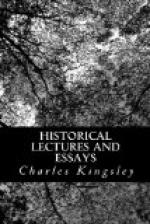If anything more important than is told by Professor Rafn and Mr. Black {2} be now known to the antiquarians of Massachusetts, let me entreat them to pardon my ignorance. But let me record my opinion that, though somewhat too much may have been made in past years of certain rock-inscriptions, and so forth, on this side of the Atlantic, there can be no reasonable doubt that our own race landed and tried to settle on the shore of New England six hundred years before their kinsmen, and, in many cases, their actual descendants, the august Pilgrim Fathers of the seventeenth century. And so, as I said, a Scandinavian dynasty might have been seated now upon the throne of Mexico. And how was that strange chance lost? First, of course, by the length and danger of the coasting voyage. It was one thing to have, like Columbus and Vespucci, Cortes and Pizarro, the Azores as a halfway port; another to have Greenland, or even Iceland. It was one thing to run south-west upon Columbus’s track, across the Mar de Damas, the Ladies’ Sea, which hardly knows a storm, with the blazing blue above, the blazing blue below, in an ever-warming climate, where every breath is life and joy; another to struggle against the fogs and icebergs, the rocks and currents of the dreary North Atlantic. No wonder, then, that the knowledge of Markland, and Vinland, and Whiteman’s Land died away in a few generations, and became but fireside sagas for the winter nights.
But there were other causes, more honourable to the dogged energy of the Norse. They were in those very years conquering and settling nearer home as no other people—unless, perhaps, the old Ionian Greeks—conquered and settled.
Greenland, we have seen, they held—the western side at least—and held it long and well enough to afford, it is said, 2,600 pounds of walrus’ teeth as yearly tithe to the Pope, besides Peter’s pence, and to build many a convent, and church, and cathedral, with farms and homesteads round; for one saga speaks of Greenland as producing wheat of the finest quality. All is ruined now, perhaps by gradual change of climate.
But they had richer fields of enterprise than Greenland, Iceland, and the Faroes. Their boldest outlaws at that very time—whether from Norway, Sweden, Denmark, or Britain—were forming the imperial life-guard of the Byzantine Emperor, as the once famous Varangers of Constantinople; and that splendid epoch of their race was just dawning, of which my lamented friend, the late Sir Edmund Head, says so well in his preface to Viga Glum’s Icelandic Saga, “The Sagas, of which this tale is one, were composed for the men who have left their mark in every corner of Europe; and whose language and laws are at this moment important elements in the speech and institutions of England, America, and Australia. There is no page of modern history in which the influence of the Norsemen and their conquests must not be taken into account—Russia, Constantinople, Greece, Palestine, Sicily, the coasts of Africa, Southern Italy, France, the Spanish Peninsula, England, Scotland, Ireland, and every rock and island round them, have been visited, and most of them at one time or the other ruled, by the men of Scandinavia. The motto on the sword of Roger Guiscard was a proud one:




